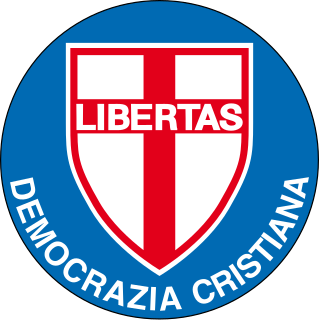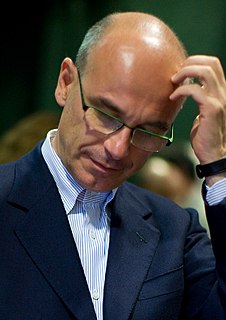 |
|---|
| This article is part of a series on the politics and government of Lombardy |
|
The Lombard regional election of 1975 took place on 15 June 1975. The 2nd term of the Regional Council was chosen.
 |
|---|
| This article is part of a series on the politics and government of Lombardy |
|
The Lombard regional election of 1975 took place on 15 June 1975. The 2nd term of the Regional Council was chosen.
Election was held under proportional representation with provincial constituencies where the largest remainder method with a Droop quota was used. To ensure more proportionality, remained votes and seats were transferred at regional level and calculated at-large.
Proportional representation (PR) characterizes electoral systems in which divisions in an electorate are reflected proportionately in the elected body. If n% of the electorate support a particular political party, then roughly n% of seats will be won by that party. The essence of such systems is that all votes contribute to the result - not just a plurality, or a bare majority. The most prevalent forms of proportional representation all require the use of multiple-member voting districts, as it is not possible to fill a single seat in a proportional manner. In fact, the implementations of PR that achieve the highest levels of proportionality tend to include districts with large numbers of seats.
The largest remainder method is one way of allocating seats proportionally for representative assemblies with party list voting systems. It contrasts with various divisor methods.
The Droop quota is the quota most commonly used in elections held under the single transferable vote (STV) system. It is also sometimes used in elections held under the largest remainder method of party-list proportional representation. In an STV election the quota is the minimum number of votes a candidate must receive in order to be elected. Any votes a candidate receives above the quota are transferred to another candidate. The Droop quota was devised in 1868 by the English lawyer and mathematician Henry Richmond Droop (1831–1884) as a replacement for the earlier Hare quota.
Despite the huge jump made by the Communist Party, which gained nearly 7 point more than five years before and won the majority of votes in Milan, the Christian Democracy party remained the largest party and incumbent president Cesare Golfari was able to form a second center-left government with the support of the PSI, the PSDI and the PRI.

The Italian Communist Party was a communist political party in Italy.

Milan is a city in northern Italy, capital of Lombardy, and the second-most populous city in Italy after Rome, with the city proper having a population of 1,372,810 while its metropolitan city has a population of 3,245,308. Its continuously built-up urban area has a population estimated to be about 5,270,000 over 1,891 square kilometres. The wider Milan metropolitan area, known as Greater Milan, is a polycentric metropolitan region that extends over central Lombardy and eastern Piedmont and which counts an estimated total population of 7.5 million, making it by far the largest metropolitan area in Italy and the 54th largest in the world. Milan served as capital of the Western Roman Empire from 286 to 402 and the Duchy of Milan during the medieval period and early modern age.

Christian Democracy was a Christian democratic political party in Italy.
Summary of the 15 June 1975 Lombard regional election
 | |||||||
| Party | Votes | % | +/− | Seats | +/− | ||
|---|---|---|---|---|---|---|---|
| Christian Democracy | DC | 2,182,347 | 37.48 | 32 | |||
| Italian Communist Party | PCI | 1,769,301 | 30.39 | 25 | |||
| Italian Socialist Party | PSI | 818,168 | 14.05 | 11 | |||
| Italian Democratic Socialist Party | PSDI | 300,973 | 5.17 | 3 | |||
| Italian Social Movement | MSI | 263,621 | 4.53 | 3 | |||
| Italian Republican Party | PRI | 179,508 | 3.08 | 2 | |||
| Italian Liberal Party | PLI | 163,117 | 2.80 | 2 | |||
| Proletarian Democracy | DP | 143,594 | 2.47 | 2 | |||
| Union of Democratic Forces | UFD | 1,452 | 0.02 | 0 | |||
| Total valid votes | 5,822,081 | 80 | |||||
| Blank votes | 155,668 | ||||||
| Invalid votes (blank included) | 217,896 | ||||||
| Total | 6,039,977 | ||||||
| Registered voters & turnout | 6,355,229 | 95.04 | |||||
Source: Ministry of the Interior
| Province | DC | PCI | PSI | PSDI | MSI | PRI | PLI | DP | Total |
|---|---|---|---|---|---|---|---|---|---|
| Milan | 11 | 13 | 5 | 2 | 2 | 2 | 1 | 1 | 37 |
| Brescia | 5 | 2 | 1 | 1 | 1 | - | - | - | 10 |
| Bergamo | 5 | 2 | 1 | - | - | - | - | 1 | 9 |
| Como | 3 | 2 | 1 | - | - | - | 1 | - | 7 |
| Varese | 3 | 2 | 1 | - | - | - | - | - | 6 |
| Pavia | 2 | 2 | 1 | - | - | - | - | - | 5 |
| Mantua | 1 | 1 | 1 | - | - | - | - | - | 3 |
| Cremona | 1 | 1 | - | - | - | - | - | - | 2 |
| Sondrio | 1 | - | - | - | - | - | - | - | 1 |
| Total | 32 | 25 | 11 | 3 | 3 | 2 | 2 | 2 | 80 |
The additional member system (AMS), also known as mixed-member proportional representation (MMP) outside the United Kingdom, is a mixed electoral system with one tier of single-member district representatives, and another tier of ‘additional members’ elected to make the overall election results more proportional.
The D'Hondt method or the Jefferson method is a highest averages method for allocating seats, and is thus a type of party-list proportional representation. The method described is named in the United States after Thomas Jefferson, who introduced the method for proportional allocation of seats in the United States House of Representatives in 1791, and in Europe after Belgian mathematician Victor D'Hondt, who described it in 1878 for proportional allocation of parliamentary seats to the parties. There are two forms: closed list and an open list.

The National Assembly is the lower house of the Parliament of South Africa, located in Cape Town, Western Cape Province. It consists of four hundred members who are elected every five years using a party-list proportional representation system where half of the members are elected proportionally from 9 provincial lists and the remaining half from national lists so as to restore proportionality.

Parliamentary elections were held in Hungary on 9 April 2006, with a second round of voting in 110 of the 176 single-member constituencies on 23 April. The Hungarian Socialist Party emerged as the largest party in the National Assembly with 186 of the 386 seats, and continued the coalition government with the Alliance of Free Democrats. It marked the first time a government had been re-elected since the end of Communist rule.

The Sardinian regional election of 2004 took place on 12–13 June 2004.

The Lombard regional election of 2005 took place on 3–4 April 2005. The 8th term of the Regional Council was chosen. Roberto Formigoni was re-elected for the third time in a row President, defeating Riccardo Sarfatti.

The Lombard regional election of 2000 took place on 16 April 2000. The 7th term of the Regional Council was chosen.

The Lombard regional election of 1990 took place on 6 May 1990. The 5th term of the Regional Council was chosen.

The Lombard regional election of 1985 took place on 12 May 1985. The 4th term of the Regional Council was chosen.

The Lombard regional election of 1980 took place on 8 June 1980. The 3rd term of the Regional Council was chosen.

The Lombard regional election of 1970 took place on 7 June 1970. It was the first-ever regional election.

The Sardinian regional election of 1994 took place on 12 and 26 June 1994.

The Tuscan regional election of 1970 took place on 7 June 1970. It was the first-ever regional election.

The Tuscan regional election of 1975 took place on 15 June 1975.

The Tuscan regional election of 1980 took place on 8 June 1980.

Tuscan regional election of 1985 took place on 12 May 1985.

The Tuscan regional election of 1990 took place on 6 May 1990.

The Sardinian regional election of 2009 took place on 15–16 February 2009.

The Italian regional elections of 1975 were held on June 15. The fifteen ordinary regions, created in 1970, elected their second assemblies. Following the 1971 census, Piedmont, Veneto and Latium had ten more seats each.

Parliamentary elections was held in Mauritania in September 2018; the first round took place on 1 September, with a second round held on 15 September. At the national level, elections were held in 157 constituencies, each electing one member to the National Assembly. Elections were also held in 13 regional councils and 219 municipalities.